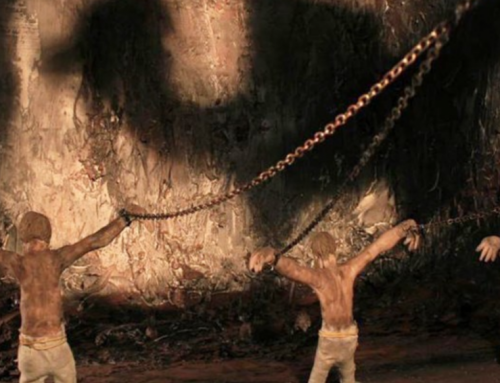Four things you might not know:
- In 1994, Carl Sagan asked NASA to have Voyager I take a photo of planet earth from 3.7 billion miles away. He called it “The Pale Blue Dot.”
- Voyager I was launched from Earth in 1978 and traveling at one million miles a day for 35 years it finally left our solar system in 2013.
- The spacecraft could remain in Interstellar space for billions of years.
- On board Voyager I is a time capsule with many things from our civilization in it, including music and a copy of Chuck Berry’s hit, “Johnny B. Goode.”
Synopsis:
We’re Johnny-come-latelies. We live in the cosmic boondocks. We emerged from microbes and muck. Apes are our cousins. Our thoughts and feelings are not fully under our own control. There may be much smarter and very different beings elsewhere. And on top of all this, we’re making a mess of our planet and becoming a danger to ourselves. – Carl Sagan
(2 minute read)
Most of us are familiar with the great Carl Sagan (1934-1996) and have seen his perspicacious video essay (3:54 min) about our home, planet Earth. It’s a must-see. Sagan captures in 355 words, what most of us viscerally understand to be a realistic “take” on what we humans are best known for at this point on our evolutionary path. Sagan had an immeasurable talent, not the least of which included his ability to communicate great ideas and address the big questions in easily understood language.
The Pale Blue Dot is both inspirational and damning, cutting through to our raw, intuitive understanding that our human behavior is verging on disastrous. After I viewed the video and read Sagan’s book, The Pale Blue Dot, I experienced the type of reflection that his thinking so often fosters, so I penned my “take” on our place on the evolutionary spectrum. I share it here, The Long View, posted below the Pale Blue Dot.
The Pale Blue Dot by Carl Sagan
That’s us. On it everyone you love, everyone you know, everyone you ever heard of, every human being who ever was, lived out their lives. The aggregate of our joy and suffering, thousands of confident religions, ideologies, and economic doctrines, every hunter and forager, every hero and coward, every creator and destroyer of civilization, every king and peasant, every young couple in love, every mother and father, hopeful child, inventor and explorer, every teacher of morals, every corrupt politician, every “superstar,” every “supreme leader,” every saint and sinner in the history of our species lived there – on a mote of dust suspended in a sunbeam.
The Earth is a very small stage in a vast cosmic arena. Think of the rivers of blood spilled by all those generals and emperors, so that, in glory and triumph, they could become the momentary masters of a fraction of a dot. Think of the endless cruelties visited by the inhabitants of one corner of this pixel on the scarcely distinguishable inhabitants of some other corner, how frequent their misunderstandings, how eager they are to kill one another, how fervent their hatreds. Our posturings, our imagined self-importance, the delusion that we have some privileged position in the Universe, are challenged by this point of pale light.
Our planet is a lonely speck in the great enveloping cosmic dark. In our obscurity, in all this vastness, there is no hint that help will come from elsewhere to save us from ourselves. The Earth is the only world known so far to harbor life. There is nowhere else, at least in the near future, to which our species could migrate. Visit yes. Settle, not yet. Like it or not, for the moment the Earth is where we make our stand. It has been said that astronomy is a humbling and character building experience.
There is perhaps no better demonstration of the folly of human conceits than this distant image of our tiny world. To me, it underscores our responsibility to deal more kindly with one another, and to preserve and cherish the pale blue dot, the only home we’ve ever known.
The Long View by David Hughes
(4 minute read)
Ironically, from 3.7 billion miles away, life on Earth comes into focus, becomes clearer. It changes our perspective; it illuminates the long view.
What are we doing on the pale blue dot?
Inhabiting it? Yes. Building on it? Yes. Creating something extraordinary? Not really. Being good stewards? Not yet.
Despite our scientific progress, our technological advancements, our intellectual achievements, we humans remain a microscopic peculiarity in the vast universe and a nanosecond in evolution. We are, at best, a momentary flash on this “point of pale light.”
As a species, our few hundred-thousand years of independence from our primate ancestors is but a blip of existence on a clump of rock that has been spinning through space for billions of years. And since our “great leap forward” some fifty-thousand years ago, we have changed very little – not the Earth, not ourselves, nothing much. Perhaps, in the last four hundred years, we have done more on the pale blue dot then all the centuries before.
But more of what?
More procreation, proliferation, exploration, travel, communications, longevity, and more wars, destruction, corruption, racism, greed, pollution and … convenience. And less of what we really need, what we are really searching for.
In the brief 12,000 years of modern history – since the last glaciers – what have we really accomplished? How is the pale blue dot different from what it was back then? How have we changed it? What have we added?
We’ve added 7.4 billion inhabitants, aggregating at a rate of 200,000 a day. A billion vehicles. Over five billion cellphones. Billions of guns. Billions of tons of plastic waste. Hundreds of billions of McDonald’s hamburgers. Millions of tons of obesity. And more botox, bad sitcoms and violent videos than any species should have to endure. Of course, we’ve added a few years to human life-expectancy, while endangering the life-expectancy of our fellow inhabitants, the rest of the animals.
Our cousins the great apes and so many of their friends face extinction: Elephants, rhinos, tigers, whales, sharks, spotted owls, polar bears, coral reefs and many more. All are on a list that too many humans consider collateral damage in the battle for what we call “progress.”
That list, in part, is a measure of how much we spend on the fleeting pleasures we get from producing and consuming rare ivory, blue fin tuna, shark fin soup, processed food, fossil fuels and the endless ingestion of nothingness. Of course, the endangered species list is a record of the irreplaceable parts on the irreplaceable pale blue dot that we all share.
We have created a world of plenty, palaces of pleasure, altars of power, towers of excess, monuments of beauty and … nations of war, ghettos of poverty, mountains of garbage, rivers of toxins, airwaves of noise, lungs of cancer and voids of meaning. And it has taken us only a few thousand years to achieve such ignoble excess, most of it in the last hundred years.
We are leaders of production, addicts for consumption and stewards of little. Producing anything, consuming everything; heading everywhere, going nowhere; searching for meaning, finding material. Are we seven billion blind mice? Do we not see the folly? Perhaps not? Perhaps not until we try and see the pale blue dot from 3.7 billion miles away. Then, maybe, through a long view, things will come into focus.
It is there, in front of us. We need only look.
The vast majority of humankind lives out their time on the pale blue dot in a space that hangs between pleasure and pain. Experiencing some of both: some great pleasure, some great pain, most in small degrees. Most ephemeral. Excitement, joy, sorrow, tragedy … the human experience. And yet, we are forever in search of more. For centuries we have trekked through life following the spirit of Nirvana, Dharma, Brahman, Mecca, Heaven – or at least the promise of these great mysterious places, all of which lie in a distant corner of the blackness, beyond our Pale Blue Dot. Why do we not believe more in what we have and what we can create rather than what we don’t know and what is promised by unknown, mythical creators?
Our Pale Blue Dot is in balance and harmony with the universe even though it’s a mere nano-particle in the vastness, moving in sync with the cosmos. The universe, the ecosystem, nature and all species seek balance and harmony, naturally and yet on this tiny spec of dust there is untold imbalance and little harmony among the human species.
Many have said that our human capability is limitless. And yet, from 3.7 billion miles away it appears that on the shallow surface of our miniscule planet we are very limited. Our need to produce and consume is insatiable. And we are good at it. But our human capability – our ability to be human – is, well … limited. Severely. We destroy much just to have more. We pile more on more, and move from more to more, striving to find more of the same. And amid the noise and haste, harmony is momentary, if at all, and balance is non-existent.
Such untapped potential. So unfulfilled.
Balance and harmony do not require billions of miles of travel, they are found in purpose, in meaning, in sharing, collaboration, peace, joy, love … they are both cause and effect. They are the ether, the medium, the quiet breath that life so yearns for. From them we feel life as it should be, see it as it can be … in perspective.
If our star is to shine, we must live in balance and harmony and take the long view of our place in the universe. We must unshackle ourselves from, as Sagan said, our “imagined self-importance.” If not, we will never escape “the folly of human conceits in our tiny world.” We are not yet stewards of our lonely speck of dust, we are but delusional inhabitants, living in denial, abdicating responsibility and pretending leadership.
We long for leaders who can lift the human spirit and begin to build a balanced society capable of dealing “more kindly with one another to preserve and cherish the Pale Blue Dot, the only home we’ve ever known.”
Think about it.






Excellent article. Excellent video. I truly miss Carl Sagan!